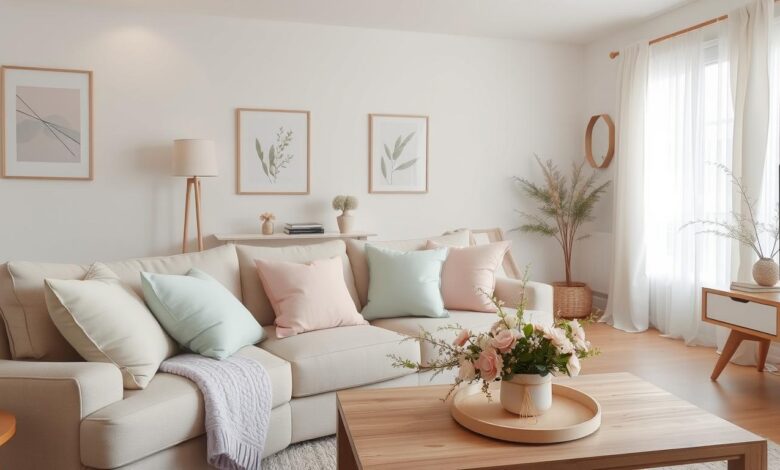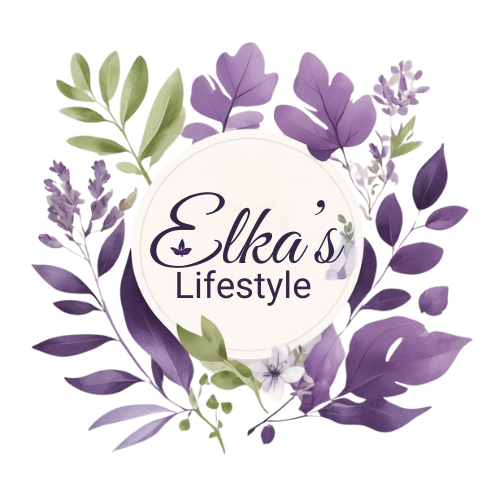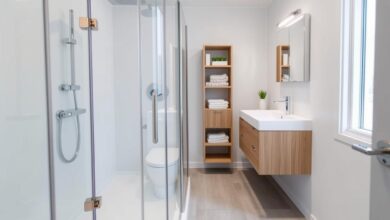Creating Cozy Neutrals and Pastels Spaces

The world is getting faster and more overwhelming. We all crave peaceful, calm places to escape the noise. Imagine walking into a room filled with soft neutrals and pastels. It wraps you in a warm hug, calming your mind and soothing your heart.
In this guide, we’ll dive into making cozy, inviting neutrals and pastels spaces. You’ll learn about the psychology of these colors and color theory. We’ll show you how to turn your home into a place of peace and calm.
Understanding the Power of Neutrals and Pastels Spaces
Your living space’s psychological impact can deeply affect your well-being. Using subtle palettes and relaxing environments can change your space for the better. Let’s explore how these design choices can shift your mood and atmosphere.
The Psychology Behind Soft Color Schemes
Color can stir up emotions and feelings. Neutrals and pastel spaces bring calm, tranquility, and balance. These soft colors soothe the mind, lowering stress and promoting relaxation.
By adding these gentle tones to your serene interiors, you make a space that’s harmonious and refreshing.
Benefits of Muted Color Palettes
- Enhance feelings of peace and serenity
- Promote better focus and concentration
- Foster a sense of comfort and coziness
- Encourage restful sleep and improved sleep quality
- Reduce visual fatigue and eye strain
Impact on Mood and Atmosphere
Using subtle palettes and relaxing environments deeply affects a space’s atmosphere. Soft colors like neutrals and pastels spaces bring tranquility and calmness, helping you relax and recharge. These design choices can uplift your mood, easing stress and anxiety while boosting relaxation and well-being.
“The colors we choose for our living spaces can have a significant impact on our psychology and overall well-being.”
By grasping the power of neutrals and pastels spaces, you can craft relaxing environments that nourish your mind and soul. Embrace the transformative power of these soft color palettes. Unlock the full benefits of a harmonious and rejuvenating living space.
Essential Color Theory for Serene Interiors
Creating a calm space starts with color theory. Soft colors, muted tones, and subtle palettes greatly affect your room’s feel. Let’s look at key principles for making peaceful, harmonious spaces.
Color temperature is key in setting a room’s mood. Warm neutrals like beige and cream bring comfort and coziness. On the other hand, cool neutrals such as gray and blue-gray create a calm, airy feel. Mixing these can make your space look smooth and connected.
Color relationships are also crucial. Complementary colors, opposite each other on the color wheel, add contrast beautifully. Using soft greens and pinks, or blues and oranges, adds a touch of elegance to your room.
For a more calming feel, try color harmonies like analogous or triadic schemes. These use colors next to or evenly spaced on the wheel. They bring a sense of unity and calm to your space.
Learning these color theory basics will help you create serene, sophisticated spaces. Use soft hues, muted tones, and subtle palettes thoughtfully for a peaceful atmosphere.
Selecting the Perfect Neutral Base Colors
Choosing the right neutral base colors is key to creating cozy spaces. These muted tones are the foundation for your desired look. It’s important to balance warm and cool neutrals for a cohesive feel.
Warm vs. Cool Neutrals
Warm neutrals like beige and tan make spaces feel cozy and inviting. Cool neutrals, such as gray and blue-toned whites, bring a calm and serene atmosphere.
Incorporating Different Shades and Tones
- Layering various shades and tones of neutrals adds depth and interest.
- Try light, medium, and dark hues for the right contrast and balance.
- Use warm or cool undertones to enrich your neutral palette.
Creating Depth with Texture
Textures are vital in making neutrals and pastels spaces lively. Mix smooth, soft, and rough textures for depth and interest. Choose fabrics, materials, and finishes like:
- Woven rugs or textiles
- Matte or lightly distressed wood surfaces
- Velvet or linen upholstery
- Natural stone or ceramic accents
By combining warm and cool neutrals, using different shades, and adding textures, you can create a soothing space. It will reflect your personal style and preferences.
Introducing Pastel Accents to Your Space
Soft hues can change your space from ordinary to serene. A neutral base is key for a calm vibe. But, adding pastel accents brings depth and interest. These subdued tones can make your decor more calming and your space more serene.
Pastel accents fit well with neutral spaces, offering many color options. Try using soft blue, pink, green, or lavender in textiles or decor. Mixing pastels and neutrals creates a balanced, peaceful look.
- Find pastel shades that match your neutral base, whether it’s warm or cool.
- Add pastel touches with throw pillows, curtains, rugs, or wall art for color pops.
- Try layering different pastel shades for a striking look.
“Pastel accents can transform a neutral space, infusing it with a sense of soft elegance and calming ambiance.“
For a balanced look, make sure pastel accents match your neutral base. This balance brings a calm, inviting space. It’s perfect for unwinding and enjoying a peaceful atmosphere.
Furniture and Material Selection for Soft Aesthetics
To make your neutrals and pastels spaces cozy and calm, choose your furniture and materials carefully. Think about the upholstery and how natural and synthetic elements work together. Each choice adds to the peaceful vibe you want to create.
Upholstery Choices
For upholstery, pick soft, plush fabrics that match your relaxing space. Velvet, linen, and microfiber are great options. They feel luxurious and welcoming. Plus, they look good with your soft colors.
Natural vs. Synthetic Materials
Using both natural and synthetic materials makes your space more interesting. Natural fibers like wool, cotton, and jute add warmth. Synthetic materials like polyester and acrylic are durable and easy to clean. Mixing them creates a balanced look that’s calming.
Mixing Textures and Finishes
Try different textures and finishes to make your space visually appealing and soothing. Smooth, glossy surfaces work well with matte, textured elements. This mix adds depth and balance, making your space sophisticated.
“The right furniture and materials can transform a space, creating a haven of tranquility and comfort.”
Lighting Strategies for Enhancing Subtle Palettes
Creating serene interiors with muted tones and soft hues is all about the right lighting. The right light can highlight your neutral and pastel colors, making your space warm and inviting. Let’s look at some ways to make your serene interiors even more subtle.
Harnessing Natural Light
Natural light is key for enhancing muted tones and soft hues. Placing windows and skylights right can bring in a soft, diffused light. This light complements your serene interiors beautifully. Use sheer curtains or blinds to control and filter this natural light, creating a calming feel.
Warm and Inviting Artificial Lighting
Artificial lighting is crucial when natural light is not enough. Choose light fixtures with warm, muted tones for a cozy glow. Dimmable lamps and sconces help you adjust the light to match your mood.
Layering for Depth and Dimension
- Use ambient, task, and accent lighting to add depth and dimension to your serene interiors.
- Ambient lighting, like floor lamps or ceiling fixtures, gives a room a general glow.
- Task lighting, such as reading lamps or under-cabinet lights, focuses on specific areas.
- Accent lighting, like wall sconces or recessed lights, highlights features or artwork, adding interest.
By layering these lighting types, you can enhance your space’s muted tones and soft hues. This creates a harmonious and welcoming atmosphere.
“Lighting has the power to transform a room, turning it from ordinary to extraordinary.”
For successful lighting in serene interiors, balance natural and artificial light. Also, consider color temperature and intensity. Mastering these strategies can make your neutral and pastel colors shine, creating a peaceful and relaxing space.
Accessorizing with Calming Decor Elements
Creating a calm and relaxing space is more than just the main colors and furniture. The little details matter a lot. When you add accessories to your calming decor, choose items that match the subtle palettes. This will make your space feel even more relaxing environments.
Textile Selection
Soft, natural fabrics like linen, cotton, and wool add warmth and comfort. Think about using plush throws, decorative pillows, and window treatments in soft colors. These will blend well with your neutral or pastel colors.
Decorative Objects and Art
Choosing the right artwork and decorative items can add interest without disrupting the calm. Look for abstract landscapes, nature prints, or simple sculptures. These should match the peaceful mood of your space.
Plants and Natural Elements
- Adding plants or fresh flowers brings nature inside. Their greenery and textures calm the space.
- Use natural materials like wood, stone, or rattan for accent pieces. This adds an earthy feel to your space.
By picking the right calming decor elements, you can make your relaxing environments even better. You’ll create a peaceful, subtle palettes space that relaxes the senses.
Maintaining Balance in Relaxing Environments
Creating a peaceful space with neutrals and pastels takes time and effort. As your life changes, it’s key to update your space gently. This way, you keep your calm atmosphere alive and welcoming.
Start by making thoughtful design changes. When adding new items, think about how they fit with your current colors. Small changes in accessories or furniture can make a big difference. Try mixing calming decor in new ways to keep your space interesting and peaceful.
Also, think about how to change your space with the seasons. Switching to lighter fabrics can change the feel of your room quickly. Adding fresh plants or seasonal flowers brings life and energy to your space. These small changes help keep your space a peaceful retreat all year round.




